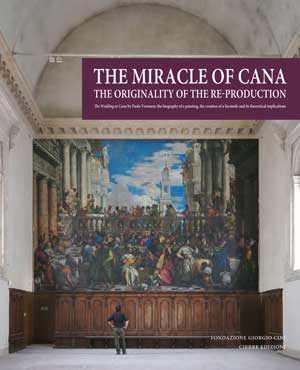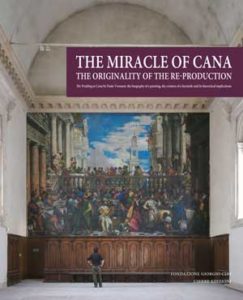The miracle of Cana. The originality of the re-production
The Wedding of Cana by Paolo Veronese: the biography of a painting, the creation of a facsimile and its theoretical implications
Questo volume racconta la storia di un grande dipinto che i monaci commissionarono a Paolo Veronese nel 1562. La tela di circa 70 metri quadri occupa l’intera parete posteriore del Refettorio di Palladio, ed è stata concepita come un logico e glorioso trompe-l’oeil a completamento dell’architettura. Il coro di lodi e la continua meraviglia che suscitava l’opera indussero Napoleone e i francesi – che avevano occupato Venezia – a confiscare l’opera nel 1797 come bottino di guerra. Fino all’arrivo del fac-simile il muro era vuoto, e questo rappresentava una ferita aperta che faceva venir meno nell’insieme l’atmosfera originaria del refettorio. L’11 settembre 2007, esattamente 210 anni dopo la sua rimozione, il fac-simile è stato “svelato” e l’opera d’arte data dalla combinazione di architettura e dipinto fu ripristinata e poté nuovamente essere ammirata.Questo libro racconta la storia di questa avventura. Esso contiene sostanzialmente tre sezioni riguardanti 1) la biografia del dipinto originale, 2) la descrizione dettagliata dei processi tecnici attraverso i quali il fac-simile è stato prodotto, 3) la riflessione critica sul significato estetico e storico di questa operazione, e ha contribuito a far luce su aspetti inediti riguardanti i problemi di conservazione e restauro. In realtà, come molte delle riflessioni fatte nella terza sezione, le nuove prospettive create dal facsimile ci portano a concepire “l’aura” in modo dinamico, come qualcosa che può “migrare” da un luogo all’altro, dall’originale alle sue “copie”.
The story told by this book is in fact about a great painting which the monks commissioned from Paolo Veronese in 1562. The canvas of about 70 square meters filled the entire rear wall of Palladio’s Refectory, and was conceived as a logical and glorious trompe-l’oeil completion of the architecture. The enduring chorus of praise and marvel induced Napoleon and the French – who had occupied Venice – to seize the work in 1797 as war reparations. Until the arrival of the facsimile, the wall remained blank and this was indeed an open wound that deconstructed the original atmosphere of the refectory. On 11 September 2007, exactly 210 years after its removal, the facsimile was “unveiled’ and the overall work of art consisting of the architecture and painting was fully reconstructed and could once more be admired. This book tells the story of this adventure. It contains basically three sections respectively concerning 1) the biography of the original painting ; 2) the detailed description of the technical processes through which the facsimile has been produced ; 3) the critical reflection on the aesthetic and historical significance of this operation, and the new light it brings on issues of conservation and restoration. Indeed, as many reflections made in the third session show, the new perspectives created by the facsimile lead us to conceive the “aura” in a dynamic way, as something which can “migrate,” from one place to another, from the original to its “copies.
In coedizione con la Fondazione Giorgio Cini
- Collana: Arte e architettura
- Argomenti: Arte - Architettura
- Anno: 2011
- Formato: 24x30 cm
- Pagine: 144
- Illustrazioni: a colori
- Rilegatura: brossura cucita con alette
- ISBN: 9788883146398
- Prezzo: 28 €



